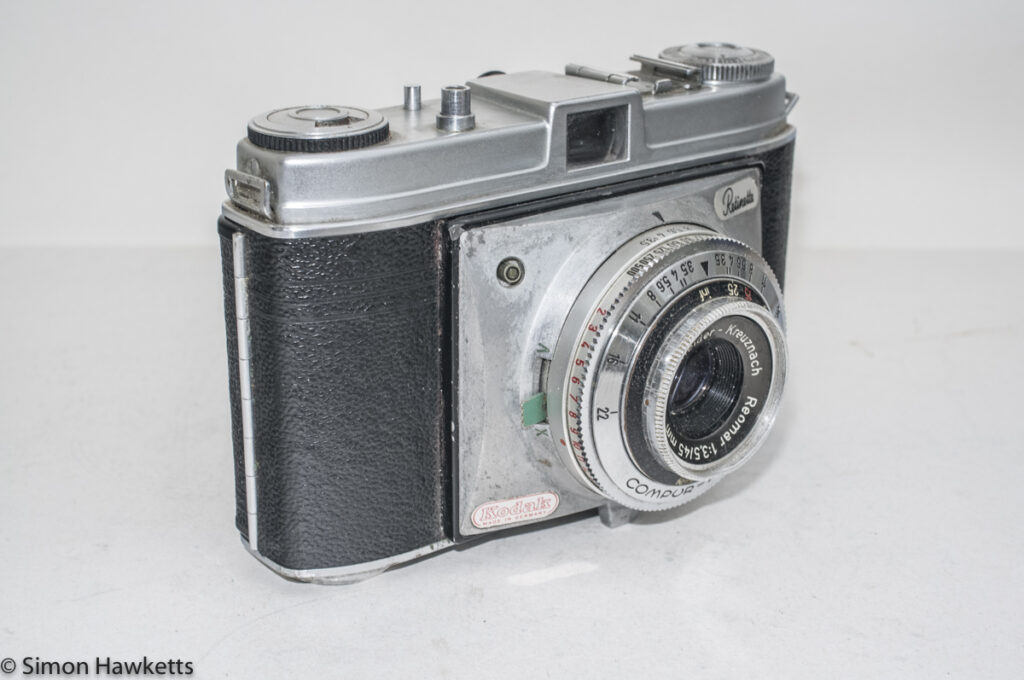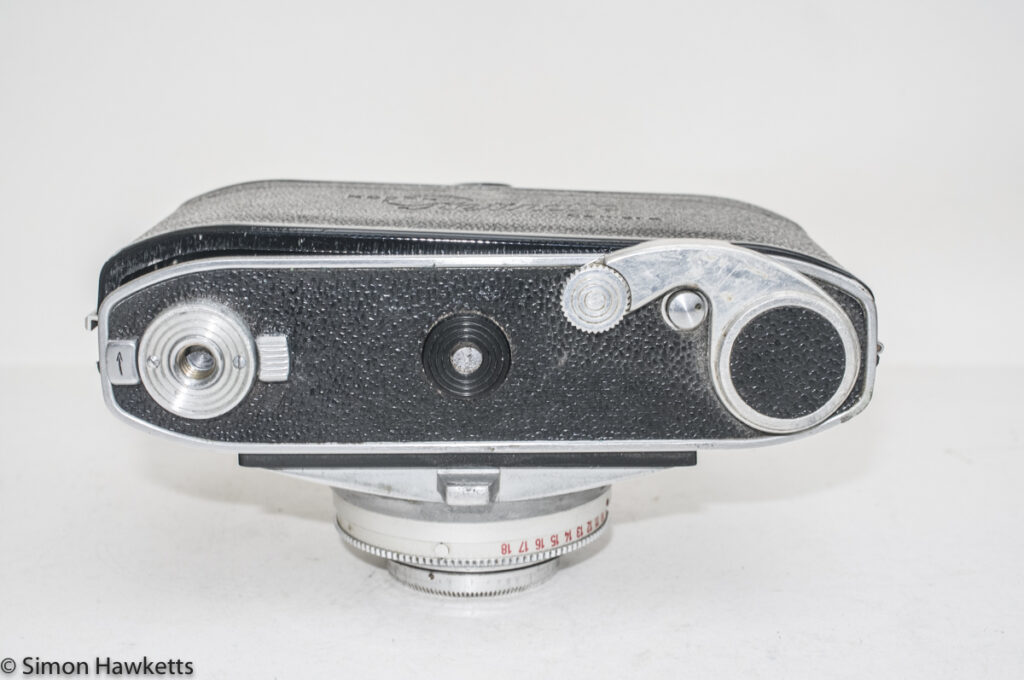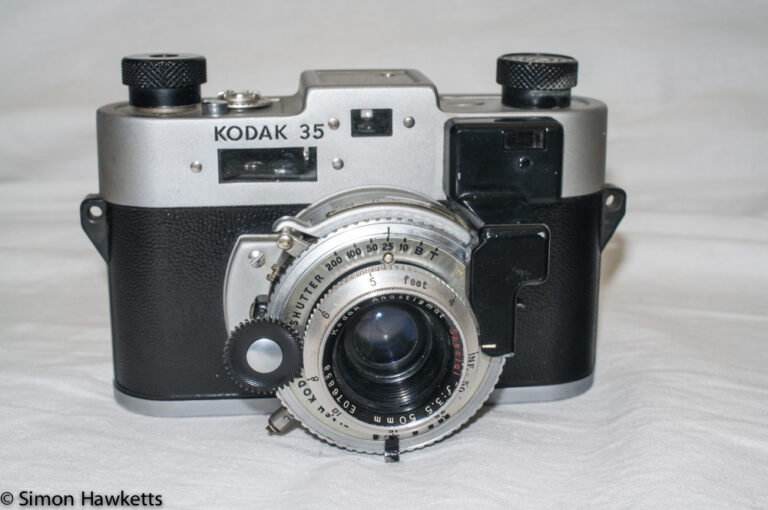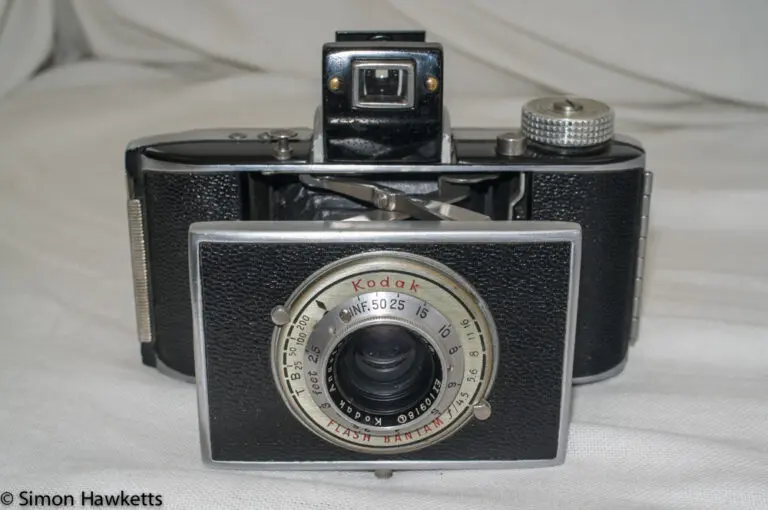Kodak Retinette type 22 from 1954
This is a short pictorial post describing the Kodak Retinette type 22, 35 mm, viewfinder camera which was made by Kodak between the years 1954 and 1958.
Kodak Retinette type 22 Images.









My Kodak Retinette type 22 camera
As with many of my camera collection, this was purchased from eBay as a non-working vintage camera, but unlike many of them there isn’t much wrong with this unit except for a problem with the back film chamber door which doesn’t lock.
OK, I suppose that could be seen as a fairly major problem because you can’t use the camera with the door open, but I suspect it can be repaired fairly easily – is simply seems to be that the door catch doesn’t quite drop far enough down to latch the door. It probably needs a clean and I suspect it will be fine.
Talking of cleaning, that is another thing the whole camera needs – most of the bright work and folds in the casing metalwork are ingrained with the dirt from the 60 or so years since it was made.
Kodak Retinette type 22 Description
The Kodak Retinette type 22 is a ‘little sister’ to the Kodak Retina cameras, which Kodak made from the mid 1930s up until the late 1960s.
Initially the Retinette series followed the same folding, bellows design that the majority of the Retina cameras had, but this model, the type 22, was the first Retinette to move to a solid body single piece design – a move which later the Retina cameras followed.
The Retinette series were aimed at people who wanted a good camera which was reliable and would take good pictures, but wanted to pay a bit less than the top flight cameras of the day. I guess you could call them a ‘good snapshot’ camera. This model has a good range of shutter speeds for a camera of its vintage and, in common with many of its cousins in the Kodak stable, a very good lens.
Exposure system
The exposure system on the Retinette type 22 is based on the EV system, which was a popular option in the mid 1950s.
It works on the premise that once you know the amount of light required for the film you are using, you can achieve it with several combinations of aperture and shutter speed. For example, if the correct exposure is 1/250 sec at f/8 you can also get the same exposure by setting the speed one stop down and the aperture one stop up, i.e. 1/500 sec at f/5.6.
This theory was used to calculate an EV or Exposure Value number, and the EV number was engraved on the camera shutter. A light meter was used to measure the light which was a simple number and the camera set to this number. Then the aperture and shutter were locked together and could be rotated by the photographer to get the artistic effect they were after; faster speed to freeze action, wider aperture to blur the background or smaller aperture to keep everything in focus.
It’s a good system and continues to this day with Program Shift, which is the modern invocation of the theory.
Film Advance
In common with many cameras in the Kodak range, the film advance is fitted to the bottom of the camera rather than the top. This is quite convenient in use but in my experience of fixing a couple of the Kodak series, it makes the camera more complex and more difficult to repair when it goes wrong.
The frame counter is on the top of the camera above the film advance lever. It’s a count-down unit and doesn’t automatically reset, so the photographer needed to set the counter to the number of exposures of the film loaded into the camera. When the film advance is used, the counter then shows the number of exposures remaining.
Other features.
There is a film type reminder fitted to the top of the film rewind shaft, a flash sync socket mounted on the front panel and, in common with many of the Retina and Retinette series, an unlock button on the top panel for occasions when you want to change the film mid-roll. This button disengages the film lock allowing the film advance to wind the camera on without cocking the shutter, therefore allowing you to advance a film to a point mid-roll.
Kodak Retinette type 22 Specifications
- 35mm viewfinder camera
- Compur rapid shutter
- Shutter speeds 1 sec to 1/500 sec + bulb
- Schneider – Kreuznach Reomar 45mm f/3.5 lens
- Aperture f/3.5 to f/16
- Film release button to allow mid-roll film changing
- Approx 10 sec Self timer
- Flash sync socket
- Cold accessory shoe
- Film Type reminder on rewind crank
- Bottom mounted film advance
- Auto frame counter
- EV exposure control
- Tripod mount
- Back door release on base of camera
- Manual focus with distance engraved in feet
- Body Ser No 910946
Discover more from Everything Vintage
Subscribe to get the latest posts sent to your email.





